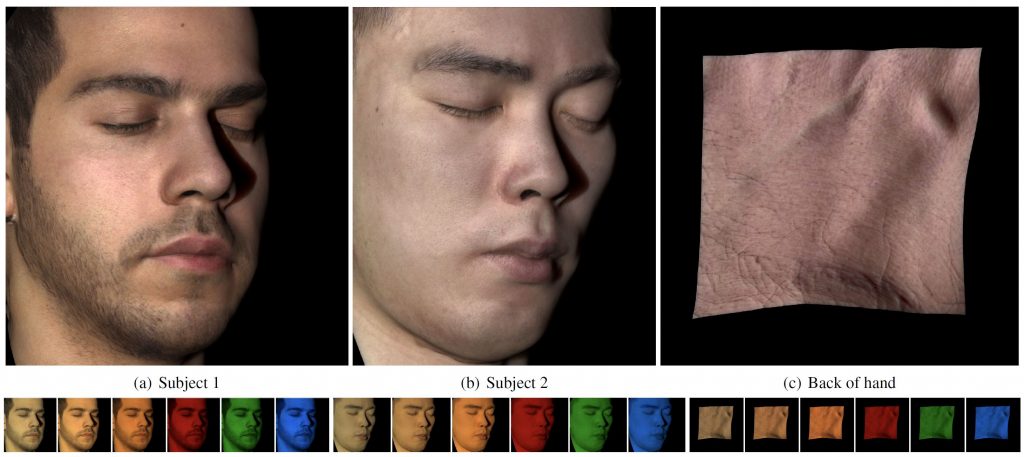Eurographics Symposium on Rendering (EGSR) 2020
Yuliya Gitlina¹ Giuseppe Claudio Guarnera² Daljit Singh Dhillon¹ ³ Jan Hansen* Alexandros Lattas¹ Dinesh Pai* Abhijeet Ghosh¹
Imperial College London ¹
NTNU and University of York ²
Clemson University ³
University of British Columbia *

Fig. 1: Renderings of acquired faces (a, b) and a patch of skin (back of hand) using our proposed practical spectral measurement and reconstruction approaches. Spatially-varying spectral skin parameters for subject 1 (a, Mediterranean skin type), and subject 2 (b, Asian skin type) acquired using an LED sphere, while the back of the hand (c, South Asian skin type) has been acquired using a hand-held dermatological skin measurement device (Antera3D). Top-row: Renderings (using PBRT) with a spectral BSSRDF under a point source illumination with broadband D65 spectrum. Bottom-row: Diffuse-only renderings under six different LED spectras (W57, W40, W27, Red, Green, Blue).
Abstract: We present two practical methods for measurement of spectral skin reflectance suited for live subjects, and drive a spectral BSSRDF model with appropriate complexity to match skin appearance in photographs, including human faces. Our primary measurement method employs illuminating a subject with two complementary uniform spectral illumination conditions using a multispectral LED sphere to estimate spatially varying parameters of chromophore concentrations including melanin and hemoglobin concentration, melanin blend-type fraction, and epidermal hemoglobin fraction. We demonstrate that our proposed complementary measurements enable higher-quality estimate of chromophores than those obtained using standard broadband illumination, while being suitable for integration with multiview facial capture using regular color cameras. Besides novel optimal measurements under controlled illumination, we also demonstrate how to adapt practical skin patch measurements using a hand-held dermatological skin measurement device, a Miravex Antera 3D camera, for skin appearance reconstruction and rendering. Furthermore, we introduce a novel approach for parameter estimation given the measurements using neural networks which is significantly faster than a lookup table search and avoids parameter quantization. We demonstrate high quality matches of skin appearance with photographs for a variety of skin types with our proposed practical measurement procedures, including photorealistic spectral reproduction and renderings of facial appearance.
Publication: Practical Measurement and Reconstruction of Spectral Skin Reflectance. Yuliya Gitlina, Giuseppe Claudio Guarnera, Daljit Singh Dhillon, Jan Hansen, Alexandros Lattas, Dinesh Pai, Abhijeet Ghosh. Computer Graphics Forum (Proc. EGSR), 39(4), 2020.
Supplementary Material: Supplementary Material.

